There are three species of Falcons that reside on Antelope Island through much of the year – the American Kestrel, Prairie Falcon and Peregrine Falcon. A fourth, the Merlin, is mostly a winter resident. For many of us there’s something almost mystical about falcons and most bird photographers I know ache to get quality shots of them. But doing so isn’t easy anywhere and Antelope Island is no exception.
In my experience there are three reasons why falcons on the island are so difficult to photograph well:
- The falcons are there but, with the exception of the kestrel, they’re difficult to find. For most of the year Peregrines and Prairies hang out in the remotest parts of the island that are inaccessible to us due to park rules and difficulties of negotiating such steep terrain. However, all three species hunt the causeway during winter so that’s the best chance for the photographer.
- Generally you just can’t get close to them. Kestrels are notorious for that trait, probably because they’re so common that lots of folks try with them. But common certainly doesn’t mean approachable. It’s not unusual to see a Peregrine perched far out on the mud flats but there’s no way to get close and if you tried they’d fly off. Prairie Falcons can often be spotted high up on the rocks around the central part of the island but they’re invariably much too far away and seldom perch near the road.
- Peregrines and Prairies are much easier to approach in very low light, especially just before sunup. But low light makes for crappy images.
I’ve included photos in this post that I think are strong images and some that are relatively weak, in order to illustrate some of the issues I’ve mentioned above.
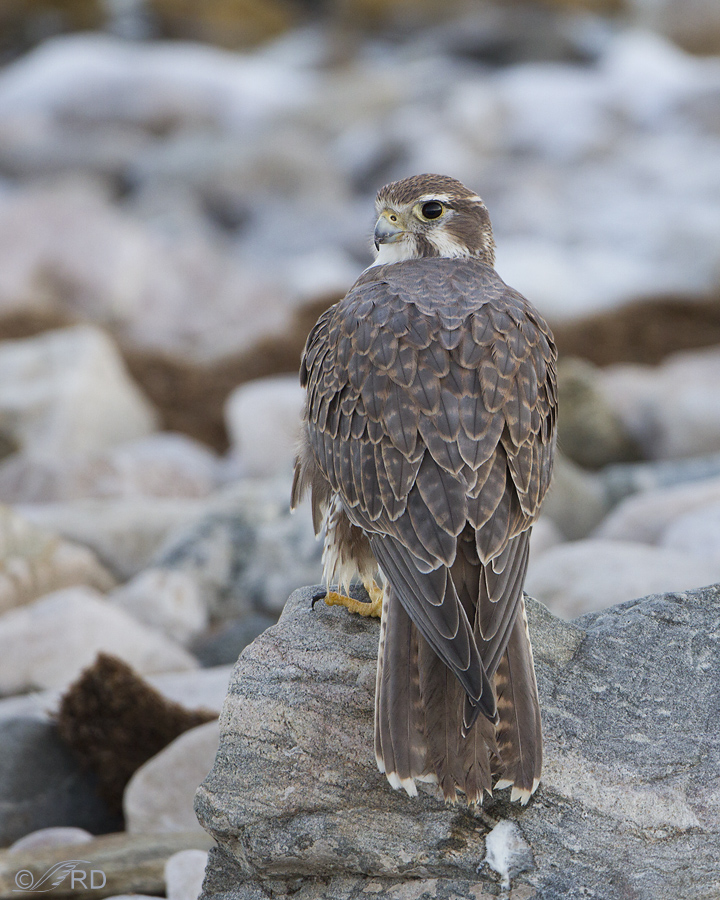
1/500, f/4.5, ISO 640, 500 f/4, natural light, not baited, set up or called in
This is the bird that got me thinking about Falcons on the island. I got very close to this Prairie Falcon along the causeway yesterday morning but the only reason it let me get so close was that it was in deep shade, which seems to make them feel much more secure. I worked with the image as best I could to try to compensate for the poor light. I like the shot and I’m happy to have it but it would be a stronger image if I’d had better light.
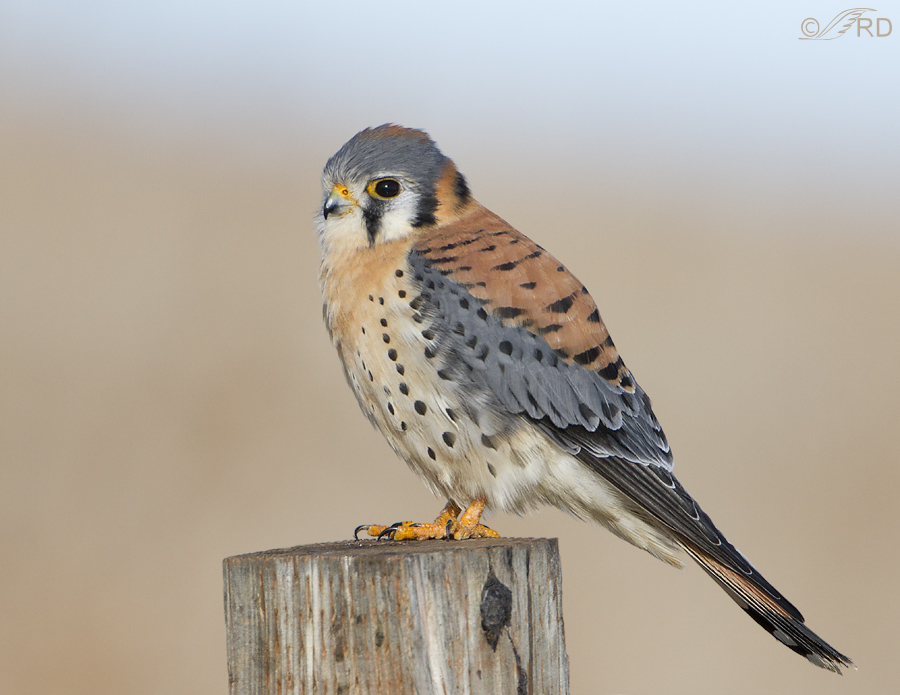
1/1600, f/7.1, ISO 500, 500 f/4, 1.4 tc, natural light, not baited, set up or called in
Our best chance is with kestrels, if for no other reason than the fact that there’s so many of them. I had pretty good light on this one and it only let me get close because it was January and very cold.
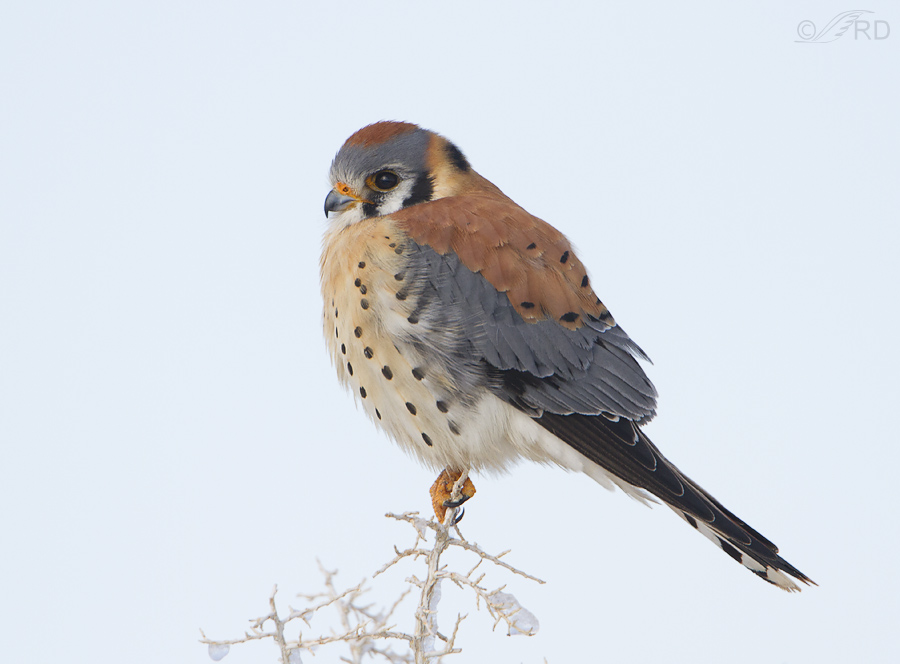
1/1250, f/6.3, ISO 500, 500 f/4, 1.4 tc, natural light, not baited, set up or called in
The light on this male kestrel was mediocre and you’re about to see why…

1/1250, f/6.3, ISO 500, 500 f/4, 1.4 tc, natural light, not baited, set up or called in
This is an extreme crop of the previous image. If you look closely at the catch light in the eye you can see the reflection of the horizon line and the sun trying mightily to shine through a very distinct cloud. That cloud foiled my attempt at a better shot.
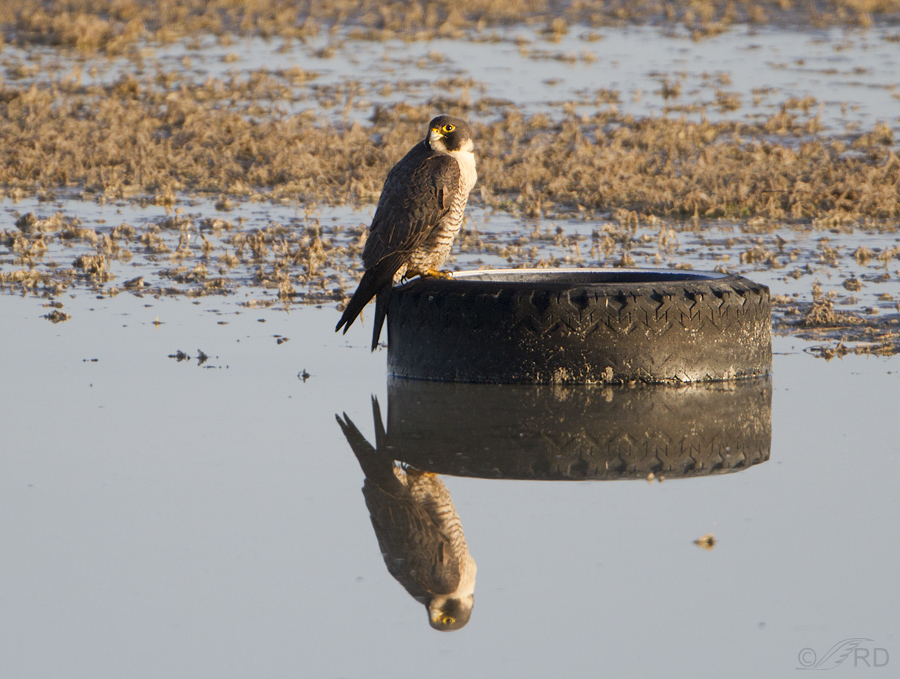
1/1250, f/5.6, ISO 640, 500 f/4, 1.4 tc, natural light, not baited, set up or called in
I mentioned earlier that it’s not unusual to see a Peregrine perched out on the mud flats. This shot is an example of that (though recent rains had left some water there). The bird was too far away (though closer than usual) and on a particularly ugly perch (at least it was a whitewall tire…)
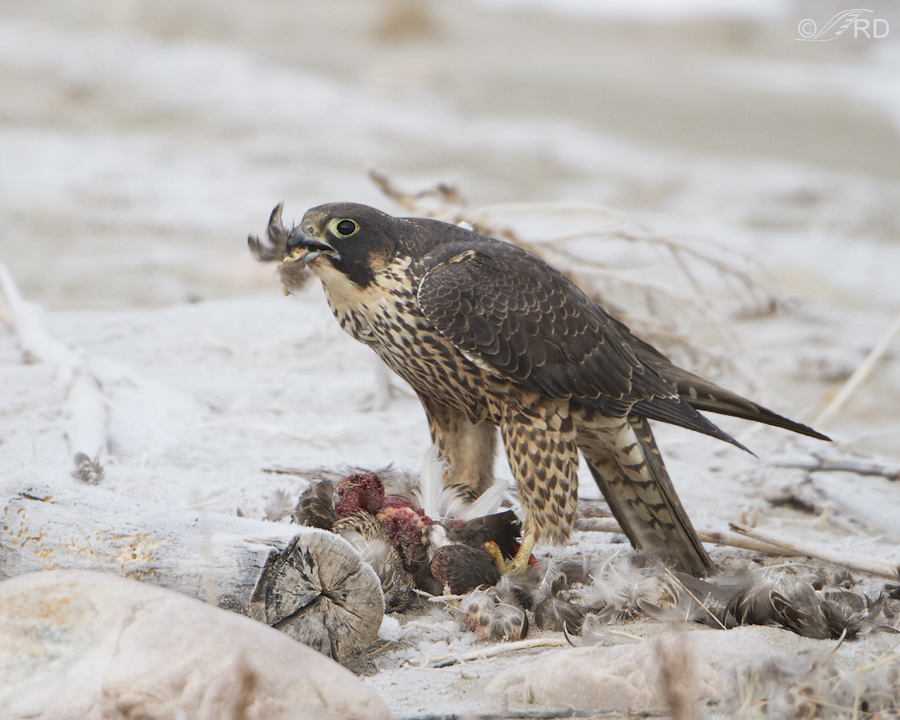
1/250, f/5.6, ISO 640, 500 f/4, 1.4 tc, natural light, not baited, set up or called in
My few close encounters with a Peregrine have been in deep shade or poor light. That light, and the fact that it was reluctant to leave its breakfast of duck, were why this bird allowed such a close approach.
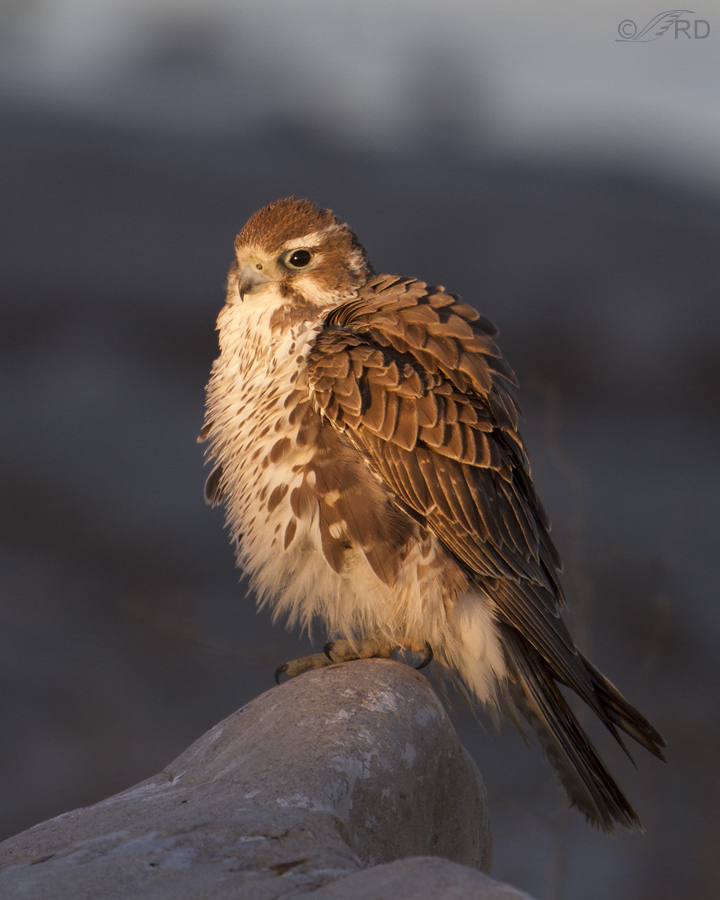
1/1250, f/5.6, ISO 640, 500 f/4, 1.4 tc, natural light, not baited, set up or called in
I’ve had better luck with Prairie Falcons on the island. This juvenile originally allowed me to get close because it was in the shadow of a road as the sun came up. But after a while it seemed to accept my presence and then sort of forgot to fly off when the light hit it. This shot was taken during the few seconds the bird was lit but the rock perch was still in shade.

1/1600, f/6.3, ISO 500, 500 f/4, natural light, not baited, set up or called in
I’ve posted this shot once before but it fits the topic. This Prairie Falcon was feeding on its Shoveler kill when two ravens began to harass it, so it took off with the duck to escape the potential food thieves. But it didn’t get very far before an adult Bald Eagle swooped in and forced the falcon to drop the duck on the ice. The eagle dropped down on the duck and flew off with it.
Ohhh, do I ever wish I’d been in position to photograph the confrontation between the falcon and the eagle!
So, the point of all this – if you want to photograph falcons on the island, go early, go when it’s very cold, expect to get skunked most of the time and bring lady luck with you. Without a doubt, you’ll need her!
Ron


I was at the Apple store when you first posted That Prairie/Shoveler image. Seeing it on a 27″ monitor made me gasp. Which then prompted me to part with a pocketful of scooty! Great falcon shots Ron. Hopefully more to come as the winter approaches…
I remember you mentioning that in your comment on that post Mike. I hope you’re enjoying the 27″ monitor, I hear it’s a great one.
Natural light, natural beauty. I think these images are great. Perfect, even. I’m not a photographer, but I do love falcons. I’ll be waiting for your natural light Gyrfalcon. Maybe this winter…? Great WORK. Your patience, knowledge and skill are very much on display here. Thanks, Ron.
Thanks so much Dick. Regarding the Gyr – highly unlikely. I saw one once but it was a quarter mile away. Still fired off a burst when it took off – couldn’t resist. 🙂
Awesome images again, Ron. I still say that you are too critical, but that goes for all of us bird photographers, wouldn’t you say. We’re never satisfied. But if you hadn’t said so, except for the Peregrine on the tire, I would not have believed that you had bad light. These are excellent. I especially love that last one with the falcon flying off with the Shoveler. It shows the ways of nature.
You’re right Bob, we do tend to be pretty critical – especially on our own images. But the light really was crappy for some of these shots. Example – that first Prairie Falcon in the post was in the deep shade of the road just as the sun was coming up over the mtns. I had to play with the image to get it to look as good as it did and I generally don’t like to do that.
You should try living under a constant cloud on the island of England! a cloud-free sky is a very rare commodity indeed! Personally, I think that these images are excellent.
Thanks Christian. Yes, I’d be tearing my hair out (if I had any) if I had to live with all the clouds and fog you endure.
Thank you. I really wish that someday I could come along for the ride on one of your photographic adventures. Cold is my friend and you see such amazing birds. An impossible dream – so I am really grateful for the photos you share. Thank you.
That would be a fun excursion for the two of us Elephant’s Child. We could compare notes on our very different species.
Fabulous shots. Love the breakfast of duck. Really, I love them all. Thank you.
Thanks very much Sharon.
The shoveler wings naturally oriented to the wind now moving across them as if they still are part of the duck body already eaten. this is truly a great shot.
Reminds me of a story of folks watching Osprey carry fish back to the nest in a daily pattern over there house. the fish are always set into the wind head first. One osprey carrying a large flounder always still stuggeling to get free fell from the birds claws and landed in these folks yard . It was soon added to the evening cookout and all was well and good.
keep up the great work Ron.
I’d eat a fresh flounder falling out of the sky too Eldridge.